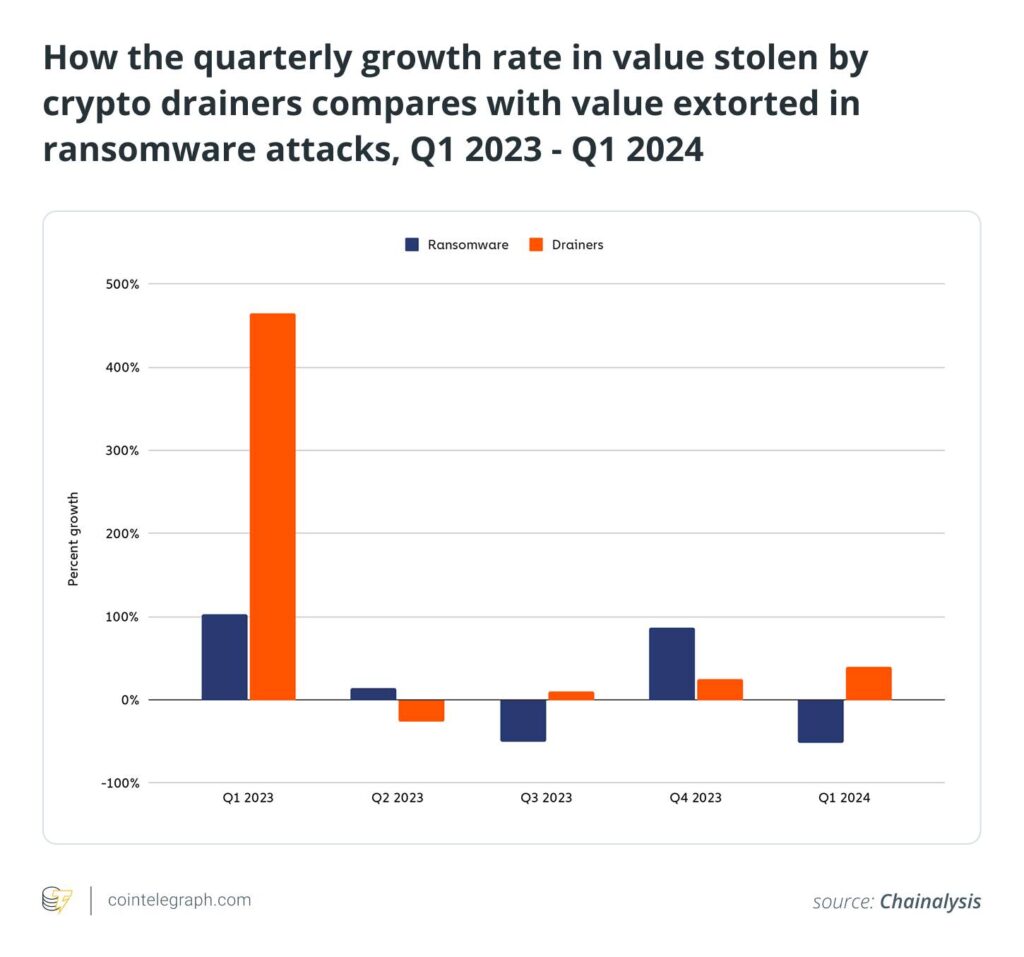The cryptocurrency landscape is increasingly fraught with risks, as savvy cybercriminals deploy sophisticated tactics to steal digital assets. A significant menace in this space is known as a “crypto drainer,” a malicious tool that deceives users into connecting their crypto wallets, allowing thieves to siphon off funds without their knowledge. Unlike traditional phishing scams that focus on stealing login credentials, crypto drainers integrate themselves into what appears to be legitimate Web3 projects, often promoted through hacked social media accounts or misleading Discord channels.
Once a user falls victim to a crypto drainer, their assets can be transferred in an instant, making this threat both rapid and devastating. The methods employed by these drainers are diverse, ranging from malicious smart contracts and fake NFTs to deceptive ads and phishing websites. Alarmingly, 2023 saw over $295 million in assets lost to such scams, showcasing an alarming trend of rapid growth and sophistication in cryptocurrency theft.
“Crypto drainers-as-a-service (DaaS)” has emerged as a commercialized model where ready-to-use theft kits are sold to scammers, making these malicious techniques accessible even to less technically skilled individuals.
The rise of DaaS has elevated the threat level, as it offers sophisticated toolkits that include phishing website templates and wallet-draining scripts, enabling attackers to launch scams with minimal effort. Crypto drainers can seamlessly integrate into counterfeit platforms and use various schemes to monitor and hijack user interactions, further complicating efforts to safeguard digital assets.
As this fraudulent activity rapidly evolves, it becomes paramount for crypto users to remain vigilant. Recognizing the warning signs, such as unauthorized transactions or suspicious activity linked to wallets, can mean the difference between protection and significant financial loss. Being informed and proactive in adopting security measures is crucial in this ever-shifting digital frontier.
Understanding Crypto Drainers and How They Affect You
Crypto drainers pose a significant threat to cryptocurrency users, designed to stealthily steal your digital assets. Here’s what you need to know to protect yourself:
- Definition of a Crypto Drainer:
- Malicious scripts that steal cryptocurrency from wallets (e.g., MetaMask, Phantom).
- Tricks users into authorizing transactions unknowingly.
- Common Forms of Crypto Drainers:
- Malicious smart contracts for unauthorized transfers.
- Fake NFTs or tokens for deceptive exchanges.
- Increasing Threat – Crypto Drainers-as-a-Service (DaaS):
- Commercialization of crypto drainers, offering malware kits to cybercriminals.
- Affordable packages allow even inexperienced hackers to access sophisticated tools.
- Indicators of a Crypto DaaS Attack:
- Unexpected transactions or lost access to your wallet may signal an attack.
- Security alerts from wallet providers should not be ignored.
- Protecting Your Crypto Wallet:
- Utilize hardware wallets to keep private keys offline.
- Enable two-factor authentication for added security.
- Steps to Take if Attacked:
- Change your wallet password immediately and transfer remaining funds.
- Notify your wallet provider and file a report with authorities.
With phishing campaigns using crypto drainers siphoning over $295 million in NFTs and tokens in 2023, remaining vigilant is crucial to protecting your assets.
The rise of crypto drainers directly impacts all users of digital assets, increasing the need for heightened awareness and security practices to prevent loss of funds.
Understanding Crypto Drainers: An Analysis of Emerging Threats
The rise of crypto drainers has introduced a new wave of challenges within the cryptocurrency landscape, making cybersecurity more critical than ever. Unlike traditional phishing attacks aimed at acquiring login credentials, crypto drainers employ a more sophisticated and deceptive approach that grants them direct access to users’ digital wallets. They masquerade as legitimate Web3 projects, luring unsuspecting investors through compromised social media accounts or dubious Discord channels.
Competitive Advantages: A notable competitive edge of crypto drainers lies in their ability to operate swiftly and stealthily, enabling instant transfers of assets without the user’s consent. The advent of Crypto Drainers-as-a-Service (DaaS) has further democratized this type of cybercrime, granting even the most inexperienced scammers access to user-friendly tools that require minimal technical expertise. This ease of entry significantly lowers the barrier for criminals, which can lead to an exponential increase in attacks. Moreover, the availability of advanced operational security tools and customer support enhances the effectiveness and operational longevity of these malicious scripts.
Disadvantages: However, the proliferation of crypto drainers can backfire, as increased instances of theft could lead to heightened scrutiny from regulators and law enforcement agencies. This growing attention may result in more stringent security protocols within exchanges and wallet services, making it harder for drainers to operate undetected. Furthermore, as users become more educated about the red flags associated with these attacks, their general wariness may hinder the effectiveness of these schemes, potentially leading to a reduction in the number of victims.
Who Could Benefit or Face Challenges: The primary beneficiaries of the crypto drainer ecosystem are, unsurprisingly, the scammers themselves, particularly those with low technical skills who can utilize DaaS to facilitate their criminal activities. On the flip side, this surge in theft can severely impact honest investors who face financial loss and eroded trust in digital currencies. Moreover, legitimate Web3 projects could find themselves suffering reputational damage as the association with fraudulent schemes creates apprehension among potential users. Security firms and cybersecurity experts may see a spike in demand for their services, as individuals and organizations seek protection against these evolving threats.
As crypto drainers continue to make headlines, the landscape of digital asset security must adapt, emphasizing the importance of robust self-protection strategies and ongoing education surrounding cryptocurrency theft. With awareness growing, stakeholders in the crypto space must remain vigilant to safeguard their assets effectively.

















